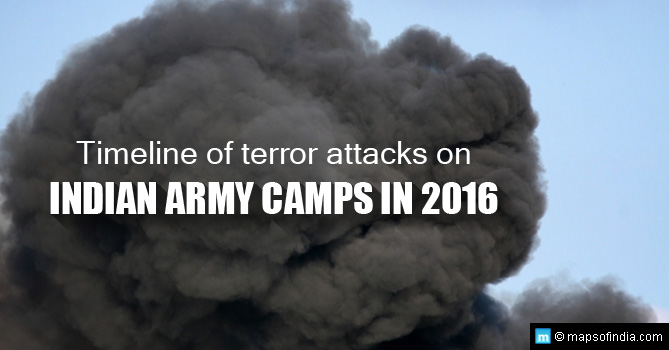On November 29, 2016, the families including wives and children of the armed forces were jolted out of their slumber to the sound of gunfire and grenades launched, as a group of terrorists attacked the army camp in Nagrota near Jammu. Two officers and five soldiers of the Indian Army were martyred in the terrorist attack on an Artillery Regiment. Two ladies and two children along with 12 soldiers were trapped in the Officer’s Mess of the regiment in a hostage-like situation and were saved by the valiant efforts of Maj Kunal Gosavi and Maj Akshay Girish Kumar, who attained martyrdom in the process.
The heavily armed terrorists, disguised as policemen, attacked the army unit and stormed into the officer’s mess launching grenades. The terrorists also tried to enter the residential buildings where families of officers are living, to try to take them hostage. However, the ladies living in the mess used household items to block the doors and thus, barred the entry of the terrorists.
Army personnel contained the situation and launched a deliberate operation to rescue the soldiers and their family members caught in the buildings, and also to neutralize the terrorists. The bodies of 3 terrorists have been recovered and operations have been conducted to sanitize the region and ensure that no more terrorists are underway.
NAMES OF MARTYRS in Nagrota Attack
– Major Gosavi Kunal Mannadir from Pandharpur, Maharashtra
– Major Akshay Girish Kumar from Koramangala, Bengaluru
– Havildar Sukhraj Singh from Maan Nagar, Punjab
– Lance Naik Kadam Sambhaji Yeshwantro from Janapuri, Maharashtra
– Grenadier Raghvendra Singh from Gadijatar, Rajasthan
– Rifleman Asim Rai from Ratanchha
– PO Khotang from Nepal
The attack coincides with General Qamar Javed Bajwa taking charge from General Raheel Sharif, who parted with a message for India: “Don’t mistake our patience for weakness.”
The brazen attack is again indicative of the ongoing escalation of infiltration by terrorists from the other side of the Line of Control (LoC) and border, and the repeated ceasefire violations by the Pakistani forces are just a cover for the infiltrators to cross over to the Indian side. The escalation in the cross-border terrorism seems to be a result of the killing of Burhan Wani as well as the surgical strike conducted by the Indian Army on Azad Kashmir following the Uri attack.
Attacks on Army Camps in 2016
The year 2016 has been one of the bloodiest years in the past half a decade for the Indian Armed Forces with 74 army personnel gaining martyrdom between January and November. The Indian Army so far has neutralised 148 terrorists, but it comes at the cost of precious lives of Indian soldiers.
- Pathankot – January 2016
The Pathankot Air Force Station, part of the Western Air Command of the Indian Air Force was attacked by a group of heavily armed terrorists on January 2, 2016. Four terrorists were killed by the security forces, but our armed forces lost three brave men including NSG’s Lt Col Niranjan, who attained martyrdom when a bomb exploded while he was inspecting a terrorist’s body.
The terrorists belonged to Jaish-e-Mohammed, an Islamist militant group.
- Pompore – June 2016
On June 25, 2016, a Central Reserve Police Force (CRPF) convoy, consisting of six vehicles, was ambushed by two militants while en route from Pantha Chowk to the town of Pampore, in Pulwama district, Jammu and Kashmir. The militants carrying AK-47s and grenades attacked a bus carrying over 40 CRPF personnel, killing eight and injuring 20 others, several of them critically. Both the militants were neutralised.
The terrorist group Lashkar-e-Taiba subsequently claimed responsibility.
- Uri – September, 2016
In one of the bloodiest attacks on the Indian Armed forces, 19 soldiers were killed in a militant attack in Uri area of Baramulla. Four fidayeen militants stormed an Army camp at Uri in Baramulla District near the LoC on September 18, 2016. The high number of casualties in the Uri terror attack was due to the fact that a large number of soldiers, of the Dogra Regiment, had been stationed at the camp in tents and other temporary structures as there was a changeover of guards. Some of these tents caught fire during the attack, and the fire spread to other parts of the barracks.
While the four terrorists were neutralised immediately, India also conducted a surgical strike in retaliation on September 29, 2016, against militant launch pads across the LoC in Pakistani-administered Azad Kashmir. Nearly 20-50 militants were neutralised as per the Indian Army.
The militant group Jaish-e-Mohammed is suspected of being involved in the planning and execution of the attack in Uri.
- Baramulla – October, 2016
On the midnight of October 3, 2016, just four days after the surgical strikes conducted by the Indian Armed Forces in Azad Kashmir, terrorists fired at and lobbed grenades on a Rashtriya Rifle Battallion in Baramulla in northern Kashmir. While the two attackers were killed by the army, one officer of the BSF attained martyrdom while several security personnel were injured.
The attackers were Pakistani nationals belonging to Jaish-e-Mohammad (JeM) militant organization.
There have been other attacks in Kupwara, Handwara, Shopian, and Zakura which fortunately were quickly contained and the militants neutralised with no casualties on the Indian side. Apart from the attacks on camps, there have also been attacks on petrol parties, and the Indian Army lost officers such as Col Santosh Mahadik, the commanding officer of the 41 Rashtriya Rifles, to martyrdom.
Indian Army Wives Speak
The repeated attacks on the Indian army camps, especially in the family stations, have got everybody worried, especially the wives of the army officers. MyIndia spoke to some of them, here’s what they have to say.
Prerna, an army wife says, “We are at war with Pak for the last 26 years in Kashmir and Siachen. In a bad day, 15 body bags leave Kashmir. In a good day it is at least two. We have become immune. Some 15000 soldiers have been killed in last 26 years. Any other country would have had enough. Nation at peace and its Army at War.”
Tulika Anand Charan, an army wife concerned about the security arrangements of army cantonments says, “Cantonments are considered to be the safest place. The attack in Nagrota alters this conception. We have to take the necessary precautions to stay safe, maybe take self defence training too, and teach our children the same. My heart goes out to everyone who is going through the ordeal of the attack at Nagrota.”
Latika, a martyrs’s wife says, “May the soldiers’ souls rest in peace. And now the struggle begins for the ladies who have lost their husbands to martyrdom. I know how difficult it is through personal experience. There will be a challenge for them now to take decisions, get work done alone, bringing up children alone with your other responsibilities.”
Sonika Uppal, another army wife says, “I remember having this same feeling during OP Parakram. The Parliament screamed, fought and mobilised the Indian army and then conveniently forgot about them. Those were the days of no cell phones or social media. I watched on TV the various MP’S and MLA’S playing holi and celebrating other festivals, while our world had come to a standstill. I feel the same feelings of angst returning. There is such a disconnect, a huge gap between us — the fauji families, our army way of life and the civilian population of our country. They are so clueless! Such a ‘chalta hai’ attitude from everyone , and it hurts to know that it is our battle alone to understand the cost of keeping this tricolour flying high.”
Counter-action
While augmented security infrastructure, access control, intrusion detection, etc. are the order of the day to stop further attacks on Indian army camps, maybe it is time for the hierarchy in the army, bureaucracy and polity to assert themselves and take a pledge to bring an end to the sponsors of cross-border terrorism once and for all.
In the meanwhile, the most precious life of the Indian population, a soldier, is defending the borders of the nation at the cost of his life. A Salute to all the Martyrs from the team of MyIndia. Jai Hind!
Read More…
Armed Forces Flag Day Today: Understanding Its Significance
The Pathankot Terror Attack: An Analysis





